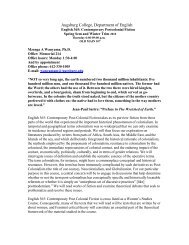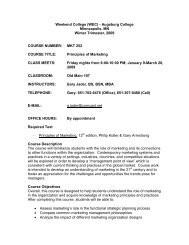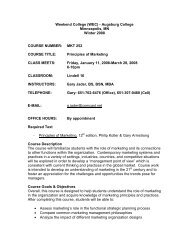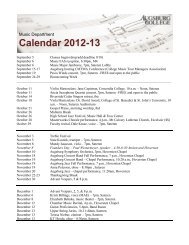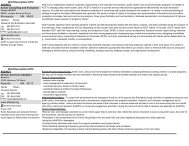You also want an ePaper? Increase the reach of your titles
YUMPU automatically turns print PDFs into web optimized ePapers that Google loves.
Gender and Multiculturalism in Math Education<br />
In the history of teaching and learning math there have been some disturbing gaps in achievement between<br />
students of different demographics. The first important achievement gap to recognize as a math teacher is between<br />
boys and girls. Statistics show blatantly that women are under-represented in the field of mathematics in<br />
our society; you can tell by entering a male-dominated college classroom, and the problem only worsens as you<br />
move to a graduate level classroom. Most argue that girls are socialized away from the math and science fields,<br />
beginning as early on in school as kindergarten. A girl is encouraged to be artistic and emotional and pursue<br />
careers working with people, while a boy is socialized to be pragmatic and objective—qualities that lead very<br />
nicely into science and math.<br />
This gender gap plays out in schools nation-wide and our Northfield schools are no exception. Some have<br />
suggested that we should be doing more to set girls up for success in math. A program like Challenge Math is<br />
an ideal environment in which to do so. By placing them in a Challenge Math group, teachers are recognizing<br />
and validating the mathematical abilities that many of our girls have. These students like math, and by leading<br />
your own Challenge Math group with the gender achievement gap in mind, you have the opportunity to nurture<br />
and reinforce girls’ confidence as mathematicians so that they can be proud, not embarrassed, or their math<br />
smarts and set an example for younger students.<br />
The racial achievement gap is in many ways like the gender gap, but it quickly becomes more complicated.<br />
The phrase ‘achievement gap’ originally referred to the comparison of academic achievement between black<br />
students and white students. Nationally it was and is still confirmed that black students perform less well in<br />
all areas of school than white students. This discrepancy is even more severe in mathematics, and now it extends<br />
to all minority students, not just black students. With immigration to the U.S. growing exponentially and<br />
students for whom English is a second language being in a majority of elementary classrooms, the achievement<br />
gap occurs due to a compilation of different ‘minority’ labels regarding race, class, and culture. Northfield<br />
schools like Bridgewater, Sibley, and Greenvale are a perfect example both of the increasing Latino immigrant<br />
population and of the achievement gap between minorities and white students in math and in general.<br />
Thinking about both achievement gaps may leave you feeling discouraged but we feel strongly that, on the<br />
contrary, these gaps can be successfully addressed and countered in Challenge Math. Because Challenge Math<br />
teachers are volunteers, we have a fresh outside perspective not tainted by a given student’s reputation among<br />
teachers or history at school from previous years. If you believe that every student has a different ideal learning<br />
style, and when they’re given the opportunity to learn in that way, they can succeed, then you can single-handedly<br />
erase the achievement gaps in one small group of students.<br />
You might not believe it at first, but you can easily make success a part of each student’s Challenge Math<br />
experiences. If Jake is good at handwriting, make him the data recorder and he can participate in a way that<br />
makes him feel competent and confident. If Suzy doesn’t like brainstorms because she’s often the last to shout<br />
out answers, make a rule that no one can speak twice until everyone speaks once. You will quickly become<br />
an adult upon whom students rely for praise, and that’s great! Students who suffer at the bottom end of the<br />
achievement gaps can and will thrive in the informal small group setting of Challenge Math.<br />
Teaching Methods<br />
The field of mathematics instruction has changed dramatically in recent history from a system that asks,<br />
“What is the right answer?” to a system that asks, “Why is the answer right?” This shift has taken hold at various<br />
levels of instruction, but it is not yet universal. Many students still think that math is boring, and some<br />
9



